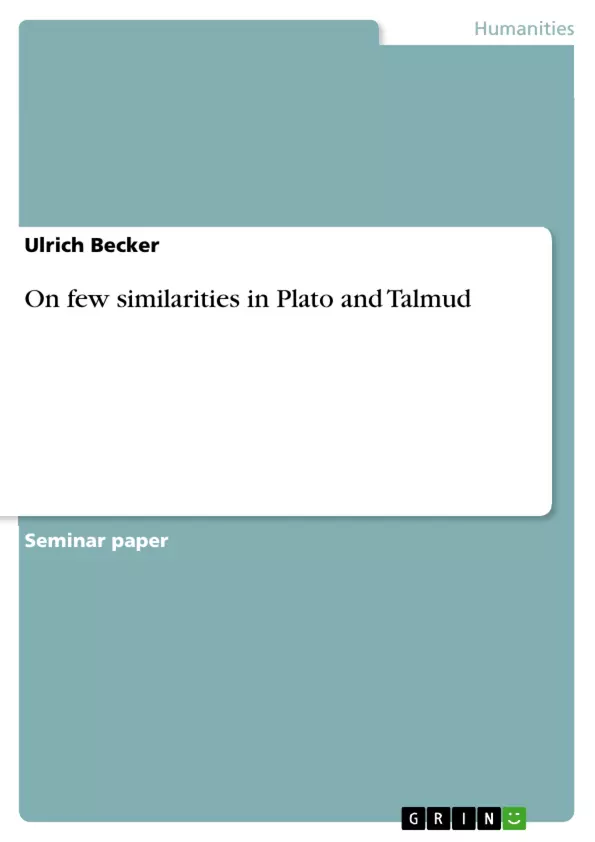We learn of four Jewish sages that entered the "Pardes" Inיד חגיגה-עטו"א(.)פרדסThere is no nearer explanation in the text for what "Pardes" actually stands for, and there are different opinions about it, only the described situations in this context can give us an idea about it. In this short work I want to compare this passage and some of its images, symbols and features with some places in Plato's Phaedo that in my opinion can be fruitful for a better understanding for both texts vice versa - in the Platonic and in the Talmudic text.
Inhaltsverzeichnis (Table of Contents)
- Short Introduction
- The Tricky Waters - Illusion and Truth
- The Case of Aher
- A Greek Connection?
- The Closeness of the Whole Difference
- A possible Historical Conclusion
Zielsetzung und Themenschwerpunkte (Objectives and Key Themes)
This short work aims to compare a passage from the Talmudic text, Hagigah, with the text of Plato's Phaedo. The author seeks to demonstrate the potential for a deeper understanding of both texts through this comparison.
- The nature of truth and knowledge
- The dangers of misinterpretation and misjudgment
- The importance of a balanced approach to epistemology, avoiding both excessive idealism and materialism
- The role of symbolism in interpreting religious texts
- The relationship between Jewish and Greek thought
Zusammenfassung der Kapitel (Chapter Summaries)
- Short Introduction: The author introduces the concept of "Pardes" in the Talmud and sets out the goal of comparing this passage with certain parts of Plato's Phaedo.
- The Tricky Waters - Illusion and Truth: This chapter examines the story of the four sages entering the "Pardes" and their experiences, highlighting the dangers of misinterpreting what is seen and the potential for harm in direct, unfiltered perception. The author then introduces Socrates' account in Plato's Phaedo, where he warns against directly looking at the sun, symbolizing the pursuit of ultimate truth. This parallels the Talmudic warning against mistaking marble for water, suggesting that both texts emphasize the importance of approaching knowledge through a mediated lens.
- The Case of Aher: This chapter focuses on the third sage, Aher, who experiences a less severe consequence than the others. The author explores the implications of this for the concept of misjudgment and how it relates to the choice of interpretation. The author also further connects this with Plato's epistemology, suggesting that the sages who interpret reality through a materialistic lens are more susceptible to misjudgment than those who approach it with an idealistic perspective.
Schlüsselwörter (Keywords)
This preview delves into the realms of Talmudic interpretation, Platonic philosophy, epistemology, symbolism, misjudgment, idealism, materialism, and the relationship between Jewish and Greek thought. The discussion centers on the crucial need for a balanced approach to knowledge, avoiding both excessive idealism and materialism, while emphasizing the importance of mediated perception to avoid misinterpretations and potential harm. The text underscores the significance of understanding the symbolic nature of religious texts, particularly in navigating complex concepts like truth, reality, and the divine.
- Quote paper
- Ulrich Becker (Author), 2006, On few similarities in Plato and Talmud, Munich, GRIN Verlag, https://www.grin.com/document/57428



